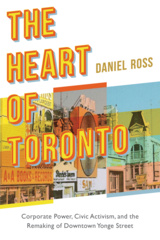
Suburb, Slum, Urban Village
Transformations in Toronto’s Parkdale Neighbourhood, 1875-2002
Suburb, Slum, Urban Village examines the relationship between image and reality for one city neighbourhood – Toronto’s Parkdale. Carolyn Whitzman tracks Parkdale’s story across three eras: its early decades as a politically independent suburb of the industrial city; its half-century of ostensible decline toward becoming a slum; and a post-industrial period of transformation into a revitalized urban village. This book also shows how Parkdale’s image influenced planning policy for the neighbourhood, even when the prevailing image of Parkdale had little to do with the actual social conditions there.
Whitzman demonstrates that this misunderstanding of social conditions had discriminatory effects. For example, even while Parkdale’s reputation as a gentrified area grew in the post-sixties era, the overall health and income of the neighbourhood’s residents was in fact decreasing, and the area attracted media coverage as a “dumping ground” for psychiatric outpatients. Parkdale’s changing image thus stood in stark contrast to its real social conditions. Nevertheless, this image became a self-fulfilling prophecy, as it contributed to increasingly skewed planning practices for Parkdale in the late twentieth century.
This rich and detailed history of a neighbourhood’s actual conditions, imaginary connotations, and planning policies will appeal to scholars and students in urban studies, planning, and geography, as well as to general readers interested in Toronto and Parkdale’s urban history.
Preface
Introduction
1 A Good Place to Live? Perceptions and Realities of Suburbs, Slums, and Urban Villages
2 The Flowery Suburb: Parkdale’s Development, 1875-1912
3 “Becoming a Serious Slum”: Decline in Parkdale, 1913-1966
4 From Bowery to Bohemia: The Urban Village, 1967-2002
5 Why Does Parkdale Matter?
Notes
References
Index








